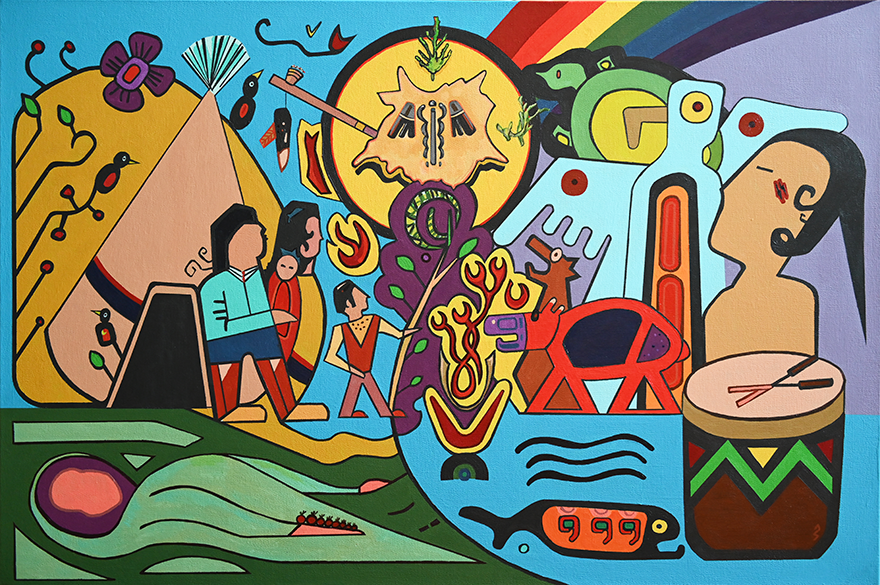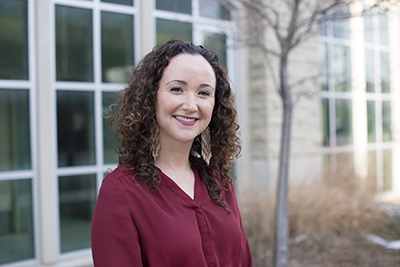Guiding the Way Forward for Indigenous Health
 Danielle Alcock, PhD, is guiding Schulich Medicine & Dentistry in creating a space that is representative of First Nations, Métis and Inuit communities as the School’s first Indigenous Lead
Danielle Alcock, PhD, is guiding Schulich Medicine & Dentistry in creating a space that is representative of First Nations, Métis and Inuit communities as the School’s first Indigenous Lead
By Crystal Mackay, MA'05
"The residential school experience is one of the darkest, most troubling chapters in our collective history... But rather than denying or diminishing the harm done, we must agree that this damage requires serious, immediate and ongoing repair.”
The Chair of the Truth and Reconciliation Commission (TRC) of Canada, Justice Murray Sinclair made these remarks on the same day the Commission presented its final Report and 94 Calls to Action. The Report calls on government, institutions, organizations and individuals to work together to become a society that champions human rights, truth and tolerance, not by avoiding this dark history but rather by confronting it.
 Danielle Alcock, PhD, Schulich Medicine & Dentistry’s first Indigenous Lead and a member of the Chippewas of Rama First Nation, will be leading the School in achieving the goals set out in the TRC Report that specifically relate to health care education. They call on educational institutions to increase Indigenous health care professionals working in the field, provide cultural competency training for health care professionals and integrate Indigenous health content into the curriculum.
Danielle Alcock, PhD, Schulich Medicine & Dentistry’s first Indigenous Lead and a member of the Chippewas of Rama First Nation, will be leading the School in achieving the goals set out in the TRC Report that specifically relate to health care education. They call on educational institutions to increase Indigenous health care professionals working in the field, provide cultural competency training for health care professionals and integrate Indigenous health content into the curriculum.
She is encouraged by the changes she’s seen at educational institutions from coast to coast as Canadians take up the call, but knows that much more still needs to be done.
In the role since February 2020, Alcock says she was compelled to take on the job after working as an Aboriginal Patient Navigator at the Southwest Ontario Aboriginal Health Access Centre, where she offered support to Indigenous patients. She says generations of systemic racism have led to a constant fear of mistreatment and distrust between patients and health care providers.
“The health care system still has a long way to go in being culturally sensitive, in seeing beyond just the patient and in understanding the importance of family and the health of a community,” she said. “I realized that in order to make change, it has to start early. Physicians and health care providers need to be educated differently.”
As an Assistant Professor in Epidemiology and Biostatistics, Alcock’s research focuses on improving culturally safe care through education, the impact of discrimination of patients and systemic barriers to care.
Guided in part by the Association of Faculties of Medicine of Canada’s (AFMC) Joint Commitment to Action on Indigenous Health, Alcock says it is important that finding ways to answer the Calls to Action is being done on the national level as well. The AFMC report charges the 17 medical schools across Canada to take up the “collective responsibility to ensure [they] are graduating physicians who understand the determinants of Indigenous peoples’ health and are courageous advocates for change.”
As a first step, Alcock worked with curriculum leads to make changes to education in endocrinology, reproductive health and foundations of medicine as part of learning for second year medical students at the School. Next, she plans to hire a full-time Indigenous curriculum developer to integrate Indigenous content across all of the education programs including Postgraduate Medical Education, Undergraduate Medical Sciences, Graduate Studies and Dentistry.
“I’m realizing that with respect to the curriculum, this is bigger than just Indigenous content being brought in,” she said. “It’s also about a shift toward education about anti-racism and anti-oppression, and giving doctors, dentists and researchers the tools that can support them to be more aware of their roles and privileges and the power dynamics in those relationships.”
She will be working to make cultural safety training available to all faculty, staff and learners, with the aim of ensuring all incoming students and a percentage of faculty in each department have completed the training within the next five years.
The other important part of her work will be finding ways to increase the number of Indigenous students who will go on to be health care providers.
Alcock says that before 1961 in Canada, Indigenous people weren’t allowed to become physicians or even obtain a university degree unless they gave up their Indian Status and revoked their treaty rights.
“That’s not that long ago,” said Alcock. “That’s an example of how the impact of a policy can determine the future for generations of people.”
She says in order to increase the number of incoming Indigenous students, there has to be an emphasis on supporting them before they even apply to medical school. “We have to be thinking about the journey toward medical school and the barriers and challenges that exist there,” she said. “It really has to be wrap-around support that starts early.”
She is working with colleagues across the country to find ways to provide more opportunities for Indigenous youth to be involved in paid research activities and get assistance with MCAT preparation, and to reduce some of the financial barriers associated with applying to medical school.
She also points out that the School has made changes to the admissions process that will help to take some of the emphasis off of MCAT scores and GPA, and focuses more on how the candidate’s ideals fit with the values of the School.
“This isn’t going to be something that is person specific — it has to be ingrained in the institution,” Alcock said. “I think the end goal is going to be making sure that Schulich Medicine & Dentistry is a space that is representative of First Nations, Métis and Inuit communities. To achieve that goal, it will be important to work with community partners to find out what that looks like, and I hope that we can foster relationships that go well beyond just my role.”
TRC Calls to Action
#23 We call upon all levels of government to:
- Increase the number of Aboriginal professionals working in the healthcare field.
- Ensure the retention of Aboriginal health-care providers in Aboriginal communities.
- Provide cultural compe-tency training for all health care professionals.
#24 We call upon medical and nursing schools in Canada to require all students to take a course dealing with Aboriginal health issues, including the history and legacy of residential schools, the United Nations Declaration on the Rights of Indigenous Peoples, Treaties and Aboriginal rights, and Indigenous teachings and practices. This will require skills-based training in intercultural competency, conflict resolution, human rights, and anti-racism.
Painting Title
Begosendang – Ojibway word meaning, “to act on a wish perceived by thought.”
By Artist Annette Sullivan
(maaskowishiiw fleur)
Annette Sullivan is a professional Indigenous artist of Métis and First Nation heritages. She is a beadsmith, milliner (one who makes hats and head-gear) and a seasoned painter. Her artwork portrays the stories of her ancestors.
Her family is part of the Muskrat Métis community of the St. Clair region. “Muskrat” describes the language and the people whose French-Canadian voyageur ancestors worked the fur trade along the waterways and tributaries of the Great Lakes. These men took Indigenous wives, and these unions melded ways that developed a unique culture in-and-of-itself; with its own style of music, art, dance, dress, food and spirituality.








